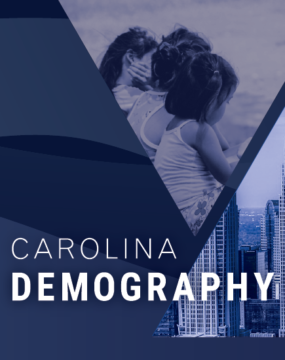Carolina Demographics
Keep up with our latest demographic insights

The 2019 county population estimates from the U.S. Census Bureau are the last set of population estimate before results of the 2020 Census are released in early 2021. Here’s what they tell us about how counties have changed in North Carolina over the past decade. Growth and Decline Statewide, North Carolina has maintained steady growth since the 2010 Census, but this growth has been uneven across the state: 57 counties have grown since 2010 –…

Last year, I wrote that the census “is kind of like the Super Bowl for demographers, if the Super Bowl only took place once a decade.” Over the past few months, Carolina Demography has been ramping up for the 2020 Census. We worked with the NC Counts Coalition to release a hard-to-count map for North Carolina. In addition, we’ve spoken at events across the state about the importance of the Census, how an undercount could…

More than 4 million Americans may not be represented in the upcoming 2020 census. This is a problem, as the once-every-10-year census affects everything from federal funding to political representation to research projects that rely on accurate census data, like the ones my colleagues and I conduct at the University of North Carolina at Chapel Hill. The 2020 census is fraught with uncertainty for a variety of reasons, including a lack of money, a growing…

Across North Carolina, there are many communities impacted by the presence of a college or university. Where will these students be counted in the 2020 Census: at their school address or at their parents’ home? According to the Census Residence Criteria, students are counted at their “usual residence” or where they live and sleep “most of the time.” This means that college students are counted at their college address, either on or off campus. They should only be counted at their parents’ home if they are living and sleeping there most of the time. The Census Bureau provides detailed information on the Residence Criteria governing college students in section C.10.a-f of the census rules.

In February, we partnered with myFutureNC to launch a statewide attainment dashboard to serve as a shared, nonpartisan source of information about the state of education in North Carolina. The dashboard tracks proven indicators along the education continuum, capturing key transition points for students from NC Pre-K enrollment through degree or credential completion and into the labor market. On the dashboard, you’ll find a simple, visual way to learn more about individual indicators, including how…

North Carolina’s population grew to an estimated 10.5 million people as of July 1, 2019, according to new estimates from the U.S. Census Bureau. From July 1, 2018 to July 1, 2019, the state’s population increased by nearly 106,500 individuals. This marks the fourth year in a row that North Carolina has grown by more than 100,000 new residents. Among the states, North Carolina had the 4th largest numeric increase since 2018. Only Texas (367K),…

Over the past year, we've worked with leaders across North Carolina, presented to dozens of organizations, and answered 150+ questions from journalists and residents with one focus: providing accurate and specific information for people to make sense of population-level changes. Below, you'll see just a small part of the work we've done this year: highlights from what we researched, learned, and shared. Thank you for your ongoing support. We wish you a Happy New Year…

2020 Update: The George Washington Institute for Public Policy has expanded its analysis of the fiscal impact of the census. According to their most recent estimate, there are $1.5 trillion dollars associated with 316 census-guided federal programs. In FY17, North Carolina received nearly $44 billion. In late June, I spoke on a panel focused on population trends in the Charlotte metropolitan region, the 2020 Census, and how businesses and local governments are gearing up for…

Nationally, there are 383 metropolitan statistical areas (MSA), which are defined as an economically integrated set of counties with a core central city with a population of 50,000 or more. They range in size from Carson City, Nevada (55,414) to the New York-Newark-Jersey City MSA (19,979,477) which crosses New York, New Jersey, and Pennsylvania. Within North Carolina, there are 17 unique metro regions, ranging from Goldsboro (123,248) to Charlotte-Concord-Gastonia (2,569,213 across NC and SC). With…

Father’s Day will be celebrated on Sunday, June 16, 2019. We’ve compiled some key stats about parenting and fatherhood in North Carolina. A record number of households in North Carolina are headed by single dads. There were 98,434 single father households in NC in 2017, an increase of more than 7,000 since 2016 and the highest number observed since 1960, when just 7,769 households with children were headed by single fathers. Single father households represented…
Your support is critical to our mission of measuring, understanding, and predicting population change and its impact. Donate to Carolina Demography today.